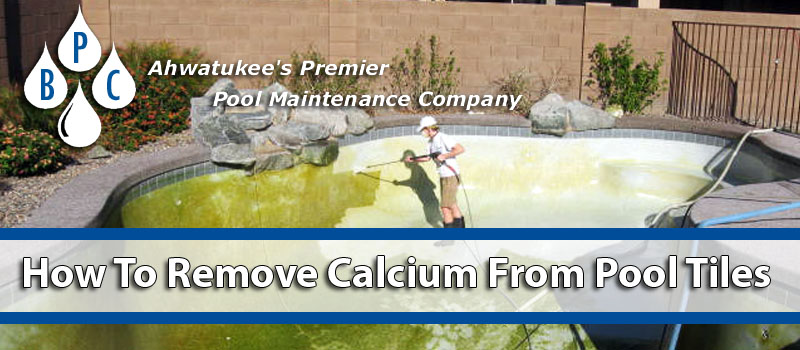If you searching for “how to remove calcium from pool tiles” or “how to remove calcium scale from pool tile”, this pool tile cleaning guide should help?
Today we are going to cover calcium scale, which is a form of calcium carbonate, also called lime scale. Most of the United States has hard water, which can cause calcium deposits to form on the surface of your pool.
What causes scale in a pool?
Calcium carbonate can happen due to evaporation during summer around your water line in the pool.
Calcium crystals will form as a nodule which dots the surface of your pool or metal surfaces and even cause crusty deposits in the corner of your pool.
This can happen due to high calcium hardness which is caused by high pH levels, high alkalinity, and high water temperatures.
How you can prevent calcium scale?
- Avoid using calcium hypochlorite shock, which will add calcium to your pool.
- Keep your pH and alkalinity low by having a 7.2-7.4 pH level and 80ppm alkalinity.
- Use a clarifier to clump calcium together to be filtered in your pump.
- Balance your Langelier Saturation Index (LSI). This is what determines the propensity to scale. A LSI calculator will accept 5 water test results and does the math for you.
How you can remove the calcium scale?
You may remove calcium scale build up using muriatic acid or using dry acid that is dissolved in water. You can use a sponge perfectly for small areas or using a watering can for the larger areas. Ensure that you are wearing gloves and safety glasses for removing scale with acid. It emits noxious fumes, will fizz and bubble as the scale build up is dissolved. Also, Acid magic can be used.
Removing Calcium Deposits On Your Pool Tile:
Lower the water level to the bottom of your tiles and prepare your acid solution. Apply it with a thick sponge or brush. Using a wire brush or putty knife can assist you in removing the deposits. Rinse it off after 1 minute with water and then reapply if it is needed.
Using a pumice or pool stone can help to remove scale as well with a bit of elbow grease.
Hiring a bead blasting service to come and remove the scale. Many use magnesium sulfate, which is a less aggressive form of salt instead of using beads or sand.
Removing Calcium Deposits On Your Pool Plaster:
Many white plaster pools will have calcium scale everywhere, but you won’t see it because of the surface being white. Black or gray plaster pools will have calcium film, but it is rather noticeable. Using acid washing, darker colors may be restored.
To remove calcium, begin with a pool stone and see if you can do the whole pool by sanding the calcium off. Or drain the pool and either acid wash or pressure wash the pool.
Removing Calcium On Efflorescence on Stonework and tile:
Similar to calcium scale from water, efflorescence occurs in grout between stone or tiles near water fixtures.
Whatever is causing the moisture to come from behind the tile or stone through the grout will bring calcium. This is the same type of process that causes stalagmites.
There are times that the moisture will come from the pool. A sealer may be used on the tile to help provide a barrier. For the larger stone or tile above the water, you may need to seal the water sources to prevent efflorescence.
For those who have hard tap water, you have my sincerest and deepest sympathies.
Even when you have hard water, you can control and prevent calcium deposits with a little elbow grease, cleaning agents and good water balance.
Professional Tile Cleaning In Ahwatukee, Arizona
If you would rather have a professional provide pool tile cleaning services for you, give Brian’s Pool Care a call today at (480) 907-7959 or schedule a free pool tile cleaning quote in Ahwatukee.





